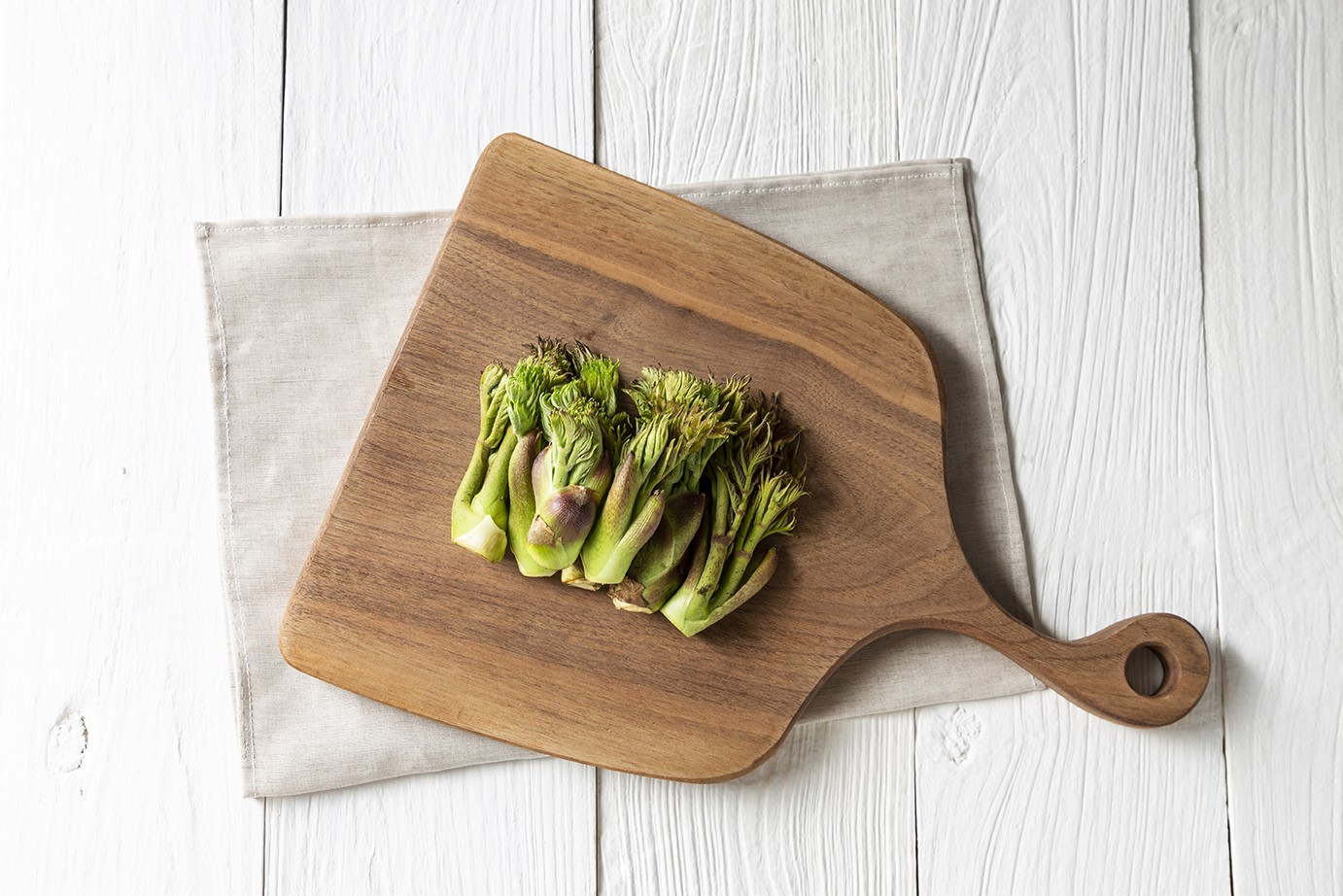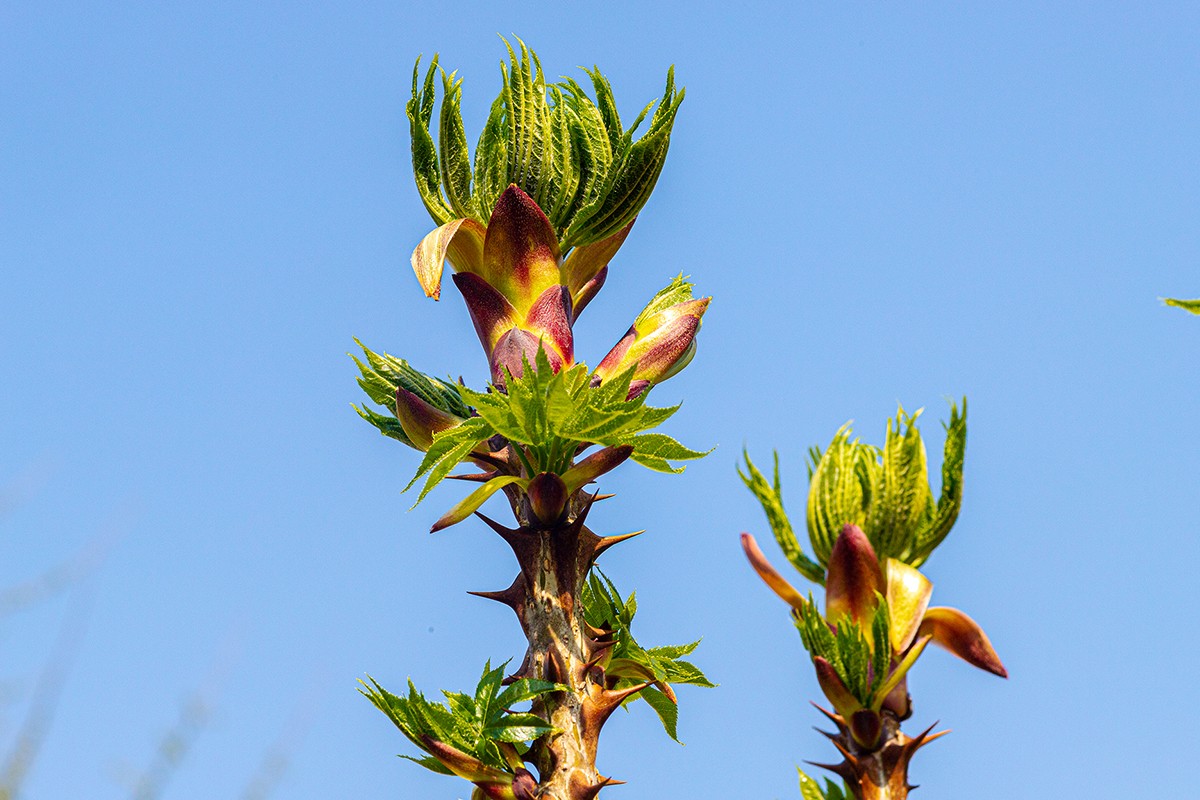한식 읽기 좋은 날
Vol 51. Korean Food that comes from trees
Discovering the flavors of spring through Korea’s three most popular tree sprouts
The Tasteful Table
Since antiquity, Koreans have enjoyed the flavors of spring through newly-picked sprouts, which, as the Korean saying goes, grow out of the ground “like bamboo after the rain” at the start of the season. Chamjuk namu sprouts, which have a distinct scent; dureup (fatsia shoots), which is also known as the “king of wild vegetables”; and eomnamu shoots, which have a strong fragrance and clean aftertaste, are best eaten from May to early June, when the daytime temperature rises significantly and there is a big temperature difference between day and night. Restore your appetite and energy levels with Korea’s three favorite tree sprouts!
Sources Korea National Arboretum; Korea Agency of Education, Promotion and Information Service in Food, Agriculture, Forestry and Fisheries; Academy of Korean Studies

Spring-harvested dureup is gold
Dureup has two defining traits: a slightly bitter flavor and a strong scent. It is also a pleasure to eat. A bite of parboiled dureup is just the right amount of chewy without being too soft. Dureup that is picked in the spring is called “springtime gold” in Korea and regarded as the “king of wild vegetables.” Dureup comes in two types: chamdureup, or tree sprouts, which grow for only a very short period of time and in small quantities, meaning that the sprout is often cut from the tree and grown in a greenhouse, and ttangdureup (meaning “does not move in the breeze”), which are shoots that come up out of the soil. Dureup is not only rich in protein but also vitamins A and C, calcium, and fiber. Furthermore, the presence of saponin (the substance responsible for the bitterness) makes dureup effective in boosting immunity levels and alleviating fatigue (by expediting blood circulation). Dureup is used for both food and Oriental/Western medicine: in terms of the latter, it is especially useful in the prevention and treatment of diabetes.
The most common way to cook dureup is parboiling. While it offers many advantages and is the cooking method that most people think to use, parboiling has the disadvantage of causing the dureup’s fragrance to be overwhelmed by the chogochujang (sweet and sour red chili paste) in which it is often dipped. This problem is easily addressed by pickling, which preserves the fragrance. Dureup can add a touch of spring flavor to sushi or bibimbap (mixed with other wild vegetables in parboiled form) and is also delicious when grilled with beef on skewers or used as the main ingredient of medicinal liquor. It is also a welcome addition to plain rice and an ingredient in doenjangguk (soybean paste stew) and kimchi.

The distinct scent of chamjuk namu sprouts
The wood of the chamjuk namu (red toon), a deciduous tree that grows to approximately 20 meters in height, is used for musical instruments and furniture because of its glossiness. The quality of its wood is rivaled only by the flavor of its sprouts. The leaves and general appearance of the chamjuk namu are very similar to those of the tree of heaven and therefore easily confused. In fact, the tree of heaven sprouts sold on the market are almost entirely from the chamjuk namu; unlike those of the chamjuk namu, however, the sprouts of the tree of heaven are inedible. One interesting feature of chamjuk namu sprouts is the onion-like scent, which is said to be unforgettable once you have tasted them in the spring as namul (salad-like mix of wild greens).
While the most common way of enjoying chamjuk namu sprouts is as namul via parboiling, it is just as delicious when dipped in gochujang (red pepper paste) or prepared as bugak (fried in glutinous rice batter). If you wish to explore less conventional cooking methods, pickled sprouts can be mixed with an assortment of nuts (e.g. almond slices, pumpkin seeds, crushed peanuts) and gochujang or parboiled in saltwater, coated in batter, and fried.

Dispelling evil spirits and restoring energy: eomnamu
The eomnamu (castor aralia), a deciduous tree in the Araliaceae family, grows to a whopping 25 meters tall. The tree, which grows individually (rather than in colonies), can be used for furniture, buildings, or musical instruments. Its inner layer and roots are used for brewing liquor or as medicinal ingredients. Due to its noticeably large thorns, a feature that is rare for native Korean trees, the eomnamu was traditionally regarded as a guardian that protects people from evil. The saying “nothing to use but an eomnamu chair,” references the eomnamu’s thorns to indicate not wishing to be involved in a certain situation but being forced to do so by forces outside of one’s control.
Eomnamu sprouts, which are called gaedureup, have a stronger scent and more tart/bitter aftertaste than dureup sprouts. Eomnamu sprouts are known to be effective in restoring energy levels, improving immunity, and fighting inflammation (e.g. arthritis, boils, cancer, skin disease) and liver/intestinal disorders (e.g. chronic hepatitis).
Eomnamu shoots taste best when parboiled and mixed with seasoning. They can also be turned into namul flavored with ssamjang (red chili and soybean paste), perilla oil, and garlic or pickled in a diluted mixture of soy sauce, vinegar, sugar, and water. Eomnamu sprouts can also be fried to make a savory jeon (a kind of Korean-style pancake), which is a snack that helps people dispel spring fatigue.

 한국어
한국어
 English
English






